Warlords
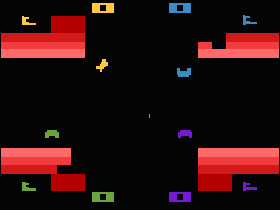
 The Game: Think of it as Pong to the death. Two to four players hurl a fireball around the playing field, smashing the walls to each other’s castles and – hopefully – hitting the other players’ kings and putting them out of commission. Using the ubiquitous Atari paddle controller, you guide a mobile barrier around your castle which bounces the fireball right back at your opponents. Fun for the whole family; based on an arcade game by Atari which is even more obscure than this rather common cartridge. (Atari, 1980)
The Game: Think of it as Pong to the death. Two to four players hurl a fireball around the playing field, smashing the walls to each other’s castles and – hopefully – hitting the other players’ kings and putting them out of commission. Using the ubiquitous Atari paddle controller, you guide a mobile barrier around your castle which bounces the fireball right back at your opponents. Fun for the whole family; based on an arcade game by Atari which is even more obscure than this rather common cartridge. (Atari, 1980)
Memories: What a great party game! With the right group of people, this game can be intense (and intensely hilarious). In this day and age in which much to do is made of internet multiplayer games, I think I’d rather be in the same room with a bunch of friends playing Warlords than doing any of this newfangled online gaming.
Super Breakout
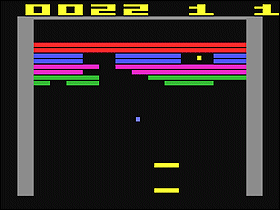
 The Game: More walls, more balls. The object of the game is the same as the original Breakout, except this time, you face things like moving walls, “cavities” which, when opened, will release additional projectiles that you’ll have to keep in the air, and more. (Atari, 1980)
The Game: More walls, more balls. The object of the game is the same as the original Breakout, except this time, you face things like moving walls, “cavities” which, when opened, will release additional projectiles that you’ll have to keep in the air, and more. (Atari, 1980)
Memories: As with the arcade version of Breakout, Breakout on the VCS was one of the better-selling launch titles on that machine, so it made sense in both cases to follow up with a sequel that had a few new twists. Originally unleashed in the arcade in 1978, Super Breakout added those twists, and this cartridge brought them home.
Space Invaders
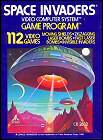 The Game: It’s quite simple, really. You’re the pilot of a ground-based mobile weapons platform, and there are buttloads of alien meanies headed right for you. Your only defense is a trio of shields which are degraded by any weapons fire – yours or theirs – and a quick trigger finger. Occasionally a mothership zips across the top of the screen. When the screen is cleared of invaders, another wave – faster and more aggressive – appears. When you’re out of “lives,” or when the aliens manage to land on Earth… it’s all over. (Atari, 1980)
The Game: It’s quite simple, really. You’re the pilot of a ground-based mobile weapons platform, and there are buttloads of alien meanies headed right for you. Your only defense is a trio of shields which are degraded by any weapons fire – yours or theirs – and a quick trigger finger. Occasionally a mothership zips across the top of the screen. When the screen is cleared of invaders, another wave – faster and more aggressive – appears. When you’re out of “lives,” or when the aliens manage to land on Earth… it’s all over. (Atari, 1980)
Memories: Is there actually any history to this game that you don’t already know? Space Invaders was what Combat and Super Breakout weren’t – namely, the Atari 2600‘s equivalent of a killer app: a home version of an arcade game that had reached a critical mass of public recognition, even among non-video-game fans. People bought the then-expensive 2600 console just to play this game.
Quest For The Rings
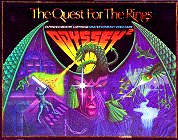 The Game: In the opening screen – the mists of time, so the rulebook tells us – two players pick their characters’ classes. Warriors are sword-wielding strongmen, wizards can cast spells from a distance, phantoms can walk through solid walls (but not lava formations), and changelings can become invisible when they move. The two intrepid adventurers then set forth on a quest to retrieve the ten rings of power from randomly selected dungeons and filled with randomly selected horrors. (Magnavox, 1980)
The Game: In the opening screen – the mists of time, so the rulebook tells us – two players pick their characters’ classes. Warriors are sword-wielding strongmen, wizards can cast spells from a distance, phantoms can walk through solid walls (but not lava formations), and changelings can become invisible when they move. The two intrepid adventurers then set forth on a quest to retrieve the ten rings of power from randomly selected dungeons and filled with randomly selected horrors. (Magnavox, 1980)
Memories: According to the rulebook, a third player (whew, is anyone else beginning to figure out why these games never caught on?) – acting as a dungeonmaster of sorts – selects the combination of mazes and monsters to challenge the players, based upon their position on a map (the aforementioned gameboard).
PBA Bowling

 The Game: Your own digital ten-pin alley awaits by way of the Intellivision. Line up your shots on two axes, and then let it fly; you still havepportunity to exert a certain amount of control on the ball as it rolls down the alley, presumably by Intellivision psychokinesis, and a split-screen view allows you to see the result of your play. You even get to see the ball return bring you ball back to you for the next play. (Mattel Electronics, 1980)
The Game: Your own digital ten-pin alley awaits by way of the Intellivision. Line up your shots on two axes, and then let it fly; you still havepportunity to exert a certain amount of control on the ball as it rolls down the alley, presumably by Intellivision psychokinesis, and a split-screen view allows you to see the result of your play. You even get to see the ball return bring you ball back to you for the next play. (Mattel Electronics, 1980)
Memories: Before the Intellivision Bowling cartridge came along, video bowling games all seemed to be cut from the same cloth: an overhead view of the alley, and very minimal control of your bowling ball. The thing is, even with a horizontally-oriented display, this resulted in a lot of wasted screen space, and nothing that was in any danger of being a satisfying gaming experience. Mattel‘s in-house team took their cues not from those earlier games, but from television bowling coverage.
Maze Craze (A Game Of Cops ‘N Robbers)
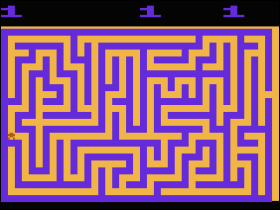
 The Game: The goal of the game is simple: race through a twisty maze and beat your opponent to the exit. Some game variations adds randomly moving “robbers” to the maze, in some cases as prey and in other cases as hunters to be avoided. (Atari, 1980)
The Game: The goal of the game is simple: race through a twisty maze and beat your opponent to the exit. Some game variations adds randomly moving “robbers” to the maze, in some cases as prey and in other cases as hunters to be avoided. (Atari, 1980)
Memories: A fairly recent transplant from Fairchild, programmer Rick Maurer’s first game for the Atari VCS was pretty familiar to anyone who had been playing games on the Fairchild Channel F: it was essentially a port of the Channel F’s Maze game on the Atari console. Like its forebear, Maze Craze is a marvelously compact piece of coding, packed into a mere 2K. Like so many early titles for the 2600, it’s a lot of fun with the right crowd.
Golf
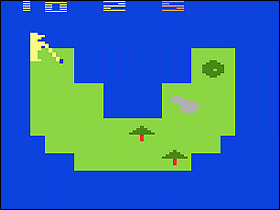
 The Game: Rouse your caddy, grab your golf bags, and get ready to hit the digital green. A series of crafty virtual courses awaits, with trees, sand traps and water hazards standing between you and the hole. (Atari, 1980)
The Game: Rouse your caddy, grab your golf bags, and get ready to hit the digital green. A series of crafty virtual courses awaits, with trees, sand traps and water hazards standing between you and the hole. (Atari, 1980)
Memories: Whoa now, what’s this then? Foreshadowing a trend that would characterize Atari’s sports game output for the rest of the 2600’s life span, a game that had already been issued on the VCS was revisited, with better graphics and game play. Atari already had Miniature Golf on the market, but it was golf-by-way-of-squares-and-rectangles, not something that a casual observer would look at and say, without prompting, that it resembled golf in any way. (I’d say it was subpar, but let’s not putter around.)
Checkers

 The Game: The timeless strategy board game of conquest comes to the Intellivision, now with 100% more boopy beepy computerish sounds from the future than any game of Checkers you’ve ever played before! Play alone against the computer, or against a second player. (Mattel Electronics, 1980)
The Game: The timeless strategy board game of conquest comes to the Intellivision, now with 100% more boopy beepy computerish sounds from the future than any game of Checkers you’ve ever played before! Play alone against the computer, or against a second player. (Mattel Electronics, 1980)
Memories: Almost a prerequisite title for any video game console back in this early days, this version of Checkers is curious in that it devotes a lot of screen real estate to showing you the men that have been taken out of play, and shrinks the board itself down to a relatively small space on the screen.
Boxing

 The Game: The sweet science of bruising is brought down to the pixellated level, as one or two players take control of a boxer seen from a view directly above the ring. The object is simple: knock your opponent out without letting him do the same to you. (Activision, 1980)
The Game: The sweet science of bruising is brought down to the pixellated level, as one or two players take control of a boxer seen from a view directly above the ring. The object is simple: knock your opponent out without letting him do the same to you. (Activision, 1980)
Memories: One of a handful of Activision‘s first releases, Boxing was one of those early sports video games that raised the bar on that entire genre by looking reasonably like the sport it was portraying, rather than something which could be described as an abstract representation at best. It also had the knack of being very easy to pick up and learn – there are no complicated combo moves here.
Blockout! / Breakdown!
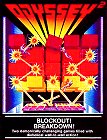 The Game: In this bizarre and uniquely Odyssey2 take on Atari’s Breakout, you battle either the computer or a second player in your attempts to blast through a wall – or repair it. You take alternating turns with your opponent; one round, you’re playing the game the more traditional way and controlling the paddle at the bottom of the screen, trying to bounce the ball toward four layers of colorful blocks. But in the next round, you’re controlling the four androids within those layers of blocks whose duty is to repair damage done by your opponent’s paddle. (Magnavox, 1980)
The Game: In this bizarre and uniquely Odyssey2 take on Atari’s Breakout, you battle either the computer or a second player in your attempts to blast through a wall – or repair it. You take alternating turns with your opponent; one round, you’re playing the game the more traditional way and controlling the paddle at the bottom of the screen, trying to bounce the ball toward four layers of colorful blocks. But in the next round, you’re controlling the four androids within those layers of blocks whose duty is to repair damage done by your opponent’s paddle. (Magnavox, 1980)
Memories: This is one of those examples of a well-worn arcade theme given a new twist by the Odyssey2 game designers. Some of you reading this are probably shaking your heads and thinking, “There they go, ripping off Atari again,” but the repair ‘droids make this a whole new game.
Asteroids

 The Game: As the pilot of a lone space cruiser, you must try to clear the spaceways of a swarm of free-floating asteroids, but the job isn’t easy – Newton’s laws of motion must be obeyed, even by asteroids. When you blow a big rock into little chunks, those chunks go zipping off in opposite directions with the speed and force imparted by the amount of energy you used to dispel them. To that screenful of bite-sized chunks o’ death, add an unpredictable hyperspace escape mechanism and a pesky UFO that likes to pop in and shoot at you, and you’re between several large rocks and a hard place. (Atari, 1980)
The Game: As the pilot of a lone space cruiser, you must try to clear the spaceways of a swarm of free-floating asteroids, but the job isn’t easy – Newton’s laws of motion must be obeyed, even by asteroids. When you blow a big rock into little chunks, those chunks go zipping off in opposite directions with the speed and force imparted by the amount of energy you used to dispel them. To that screenful of bite-sized chunks o’ death, add an unpredictable hyperspace escape mechanism and a pesky UFO that likes to pop in and shoot at you, and you’re between several large rocks and a hard place. (Atari, 1980)
 Memories: This better-than-average translation of Atari’s own arcade smash-hit (in every sense of the term) probably has a lot to do with the game’s enduring popularity.
Memories: This better-than-average translation of Atari’s own arcade smash-hit (in every sense of the term) probably has a lot to do with the game’s enduring popularity.
Alien Invaders – Plus!
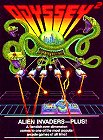 The Game: It’s quite simple, really. You’re the pilot of a ground-based mobile weapons platform, and there are buttloads of alien meanies headed right for you. Your only defense is a trio of shields and a quick trigger finger. If your cannon is destroyed, its pilot must run for cover; each of the three shields contains an extra cannon. When all three shields are gone, the alien commander – a kind of spaceborne crab – will descend to nearly ground level and hunt the helpless pilot down. Ten rounds of this decide the outcome of the war. (Magnavox, 1980)
The Game: It’s quite simple, really. You’re the pilot of a ground-based mobile weapons platform, and there are buttloads of alien meanies headed right for you. Your only defense is a trio of shields and a quick trigger finger. If your cannon is destroyed, its pilot must run for cover; each of the three shields contains an extra cannon. When all three shields are gone, the alien commander – a kind of spaceborne crab – will descend to nearly ground level and hunt the helpless pilot down. Ten rounds of this decide the outcome of the war. (Magnavox, 1980)
Memories: Alien Invaders – Plus! was the first Odyssey 2 game I got hooked on, and my mother just thought it was riotously funny, especially the bit where the giant space squid floats down from the top of the screen to chase your unprotected gunner around when all of your defenses have been depleted.
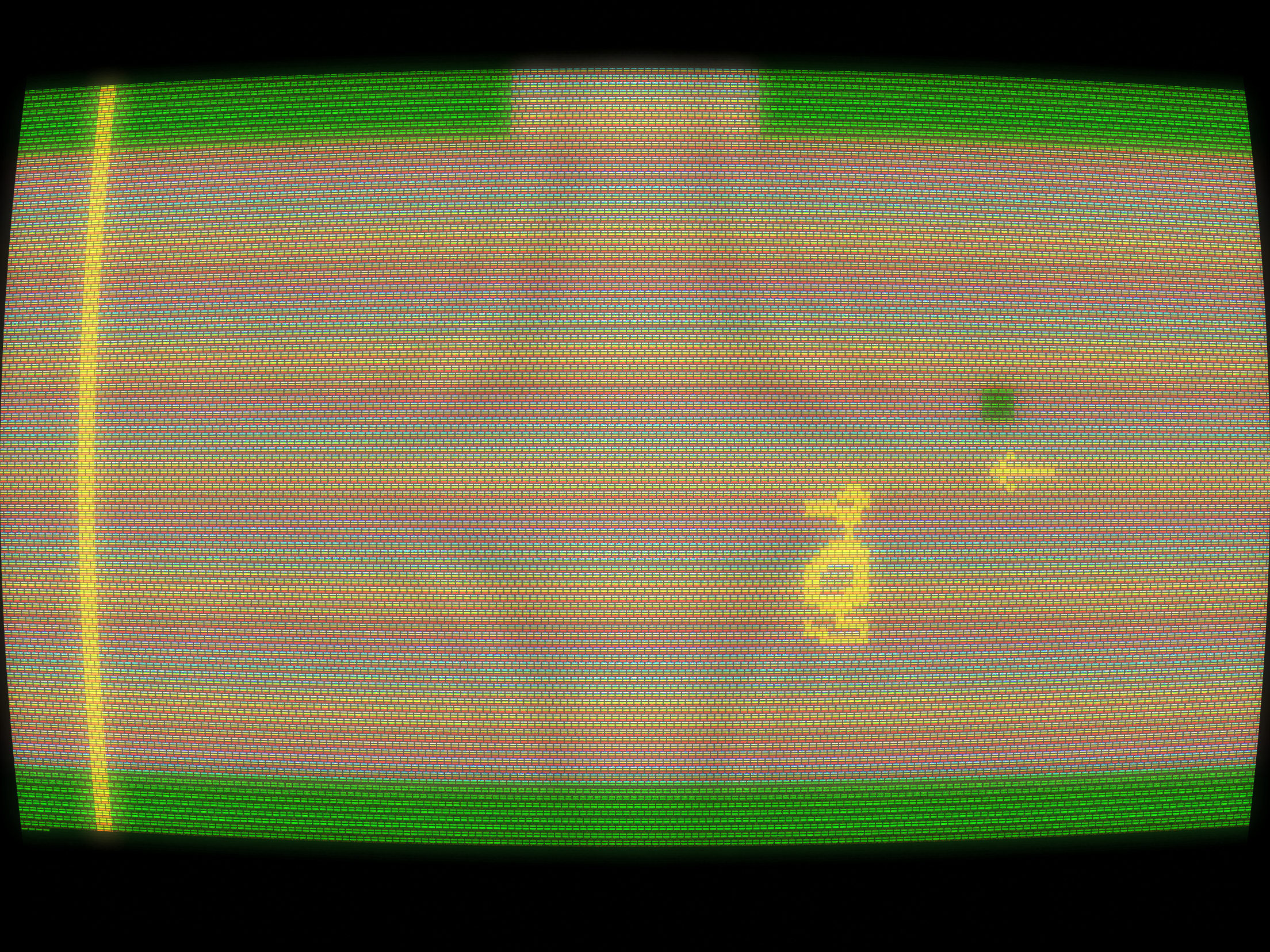
Adventure
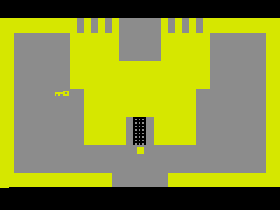
 The Game: As a bold adventurer trespassing a mighty castle in search of treasure, you face a twisty maze of chambers, dead ends aplenty, and colorful, hungry, and suspiciously duck-shaped dragons. (Atari, 1980)
The Game: As a bold adventurer trespassing a mighty castle in search of treasure, you face a twisty maze of chambers, dead ends aplenty, and colorful, hungry, and suspiciously duck-shaped dragons. (Atari, 1980)
Memories: The first game of its kind to hit the Atari VCS, Adventure scores a first in video game history – and not just because of its huge, sprawling maze.
Programmer Warren Robinett was a little disgruntled during his stint at Atari. He watched as his fellow programmers jumped ship, formed companies like Imagic and Activision, and struck it rich as the third-party software industry took off.
Star Castle
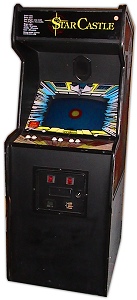 The Game: You control a lone space fighter in the immediate vicinity of the nearly-impenetrable Star Castle. Its three layers of shields rotate, but those layers aren’t solid, so you might be able to get a shot in and destroy the alien craft at its center – but it’s also just as likely that the alien will get a clear shot at you…and its firepower is far greater. (Cinematronics, 1980)
The Game: You control a lone space fighter in the immediate vicinity of the nearly-impenetrable Star Castle. Its three layers of shields rotate, but those layers aren’t solid, so you might be able to get a shot in and destroy the alien craft at its center – but it’s also just as likely that the alien will get a clear shot at you…and its firepower is far greater. (Cinematronics, 1980)
Memories: Tim Skelly’s all-time arcade classic managed to get a cult following despite being eclipsed technologically by some of its contemporaries. In order to get its three rotating shield rings to be multicolored, Star Castle relied on transparent overlays on the monitor – not unlike the TV screen overlays of the original Magnavox Odyssey home video game console – to provide that color.
Space Panic
 The Game: An astronaut is trapped in an enclosed, vertical space with aliens who have a taste for human flesh. With his oxygen supply running out, he must dig holes in the floors of the multi-level structure and lure the aliens into those holes, which gives him mere seconds to dispose of the trapped aliens by filling the holes in. Clearing a level of aliens replenishes the oxygen tank and deposits the player on a new screen full of aliens, some of whom require extra effort – namely, the carefully-planned digging of an entire vertical shaft to fall through – to kill. (Universal, 1980)
The Game: An astronaut is trapped in an enclosed, vertical space with aliens who have a taste for human flesh. With his oxygen supply running out, he must dig holes in the floors of the multi-level structure and lure the aliens into those holes, which gives him mere seconds to dispose of the trapped aliens by filling the holes in. Clearing a level of aliens replenishes the oxygen tank and deposits the player on a new screen full of aliens, some of whom require extra effort – namely, the carefully-planned digging of an entire vertical shaft to fall through – to kill. (Universal, 1980)
Memories: A fiendishly hard and oft-copied game (particularly in the home computer arena, where it inspired such games as Apple Panic and Lode Runner), Space Panic may well be the first game of its kind: a game in which the player controls someone climbing up and down vertical levels on the screen.
Rally-X
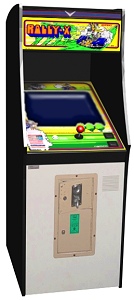 The Game: Go, Speed Racer, go! (Well, almost.) As the driver of a high-powered race car, you rocket around corners and down straightaways, trying to pick up every yellow flag in the maze-like course and avoiding deadly collisions with pursuing red cars. Watch out for rocks and oil spills, and use your smokescreen
The Game: Go, Speed Racer, go! (Well, almost.) As the driver of a high-powered race car, you rocket around corners and down straightaways, trying to pick up every yellow flag in the maze-like course and avoiding deadly collisions with pursuing red cars. Watch out for rocks and oil spills, and use your smokescreen  only when necessary to distance yourself from the red cars. (Bally/Midway [under license from Namco], 1980)
only when necessary to distance yourself from the red cars. (Bally/Midway [under license from Namco], 1980)
Memories: Namco released Rally-X at the same time as Pac-Man, and like Pac-Man, Namco licensed Rally-X to Midway. In fact, the major buzz at that year’s AMOA (Amusement Machine Operators’ Association) annual trade show – where arcade owners tried to figure out which would be the hottest new games to buy for their establishments – was for this dandy little racing/maze game, and Pac-Man was considered an also-ran, perhaps a little too abstract for the U.S. market.
Moon Cresta

 The Game: As commander of the three-stage fighter rocket Moon Cresta, your job is to ward off endless varieties of evasively weaving space attackers. Every time you knock out two consecutive screens of assailants, you’ll have an opportunity to dock your ship to another one of Moon Cresta’s three stages, until all three portions of the ship are combined to create one bad-ass weapons platform. But you can also lose stages very quickly, ending your game – a bigger ship makes a bigger and easier target. (Sega/Gremlin [under license from Nichibutsu], 1980)
The Game: As commander of the three-stage fighter rocket Moon Cresta, your job is to ward off endless varieties of evasively weaving space attackers. Every time you knock out two consecutive screens of assailants, you’ll have an opportunity to dock your ship to another one of Moon Cresta’s three stages, until all three portions of the ship are combined to create one bad-ass weapons platform. But you can also lose stages very quickly, ending your game – a bigger ship makes a bigger and easier target. (Sega/Gremlin [under license from Nichibutsu], 1980)
Memories: Moon Cresta had a very cool idea which was ripped off by a handful of its contemporaries – instead of giving the player a set number of “lives,” players had three rocket stages. Losing even one stage could seriously hamper your life expectancy in the game in later levels, and you could lose a stage to anything from enemy fire to not lining your stages up correctly during docking. This actually made Moon Cresta a very challenging game – but also a very fun one.
Missile Command

 The Game: Tucked away safely in an underground bunker, you are solely responsible for defending six cities from a relentless, ever-escalating ICBM attack. Your three missile bases are armed with nuclear missiles capable of intercepting the incoming enemy nukes, planes and smart bombs. One nuke hit on any of your three launch bases will incapacitate that facility for the rest of your current turn, but one nuke hit on any of your six cities will destroy it completely. (The only chance you have of rebuilding a city comes when a bonus city is awarded for every 10,000 points scored.) And when all six of your cities have been destroyed, the cataclysmic end of the world proceeds. Game over. (Atari, 1980)
The Game: Tucked away safely in an underground bunker, you are solely responsible for defending six cities from a relentless, ever-escalating ICBM attack. Your three missile bases are armed with nuclear missiles capable of intercepting the incoming enemy nukes, planes and smart bombs. One nuke hit on any of your three launch bases will incapacitate that facility for the rest of your current turn, but one nuke hit on any of your six cities will destroy it completely. (The only chance you have of rebuilding a city comes when a bonus city is awarded for every 10,000 points scored.) And when all six of your cities have been destroyed, the cataclysmic end of the world proceeds. Game over. (Atari, 1980)
Memories: Possibly the first video game ever to register on the so-called moral compass, Atari’s Missile Command contained a strong, anti-nuclear message, arriving at the dawn of Ronald Reagan’s presidency. For those of you who weren’t alive at that time, here’s a little bit of historical context.
Centipede
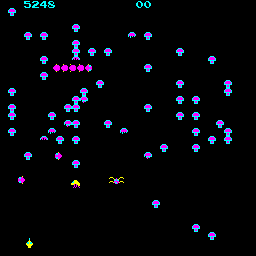
 The Game: Apparently, the exterminating business is getting more dangerous. In the course of trying to wipe out some vermin, you find yourself on the defensive – any of them can kill you simply by touching you. Fleas drop from the top of the screen, leaving bothersome mushrooms in their way. Scorpions periodically poison the mushrooms, making them impossible to destroy. And a pesky spider is always dancing around the screen. (Atari, 1980)
The Game: Apparently, the exterminating business is getting more dangerous. In the course of trying to wipe out some vermin, you find yourself on the defensive – any of them can kill you simply by touching you. Fleas drop from the top of the screen, leaving bothersome mushrooms in their way. Scorpions periodically poison the mushrooms, making them impossible to destroy. And a pesky spider is always dancing around the screen. (Atari, 1980)
Memories: I was never that hot on Centipede, but this is mainly due to the fact that its trakball controller pretty much ensured that I sucked at this game. But many people just loved it. With the benefit of hindsight, and slightly better hand-eye coordination, I can now see why.
Berzerk
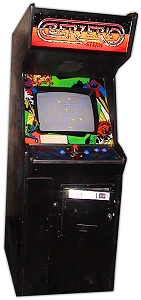 The Game: You’re alone in a maze filled with armed, hostile robots who only have one mission – to kill you. If you even so much as touch the walls, you’ll wind up dead. You’re a little bit faster than the robots, and you have human instinct on your side…but even that won’t help you when Evil Otto, a deceptively friendly and completely indestructible smiley face, appears to destroy you if you linger too long in any one part of the maze. The object of the game? Try to stay alive however long you can. (Stern, 1980)
The Game: You’re alone in a maze filled with armed, hostile robots who only have one mission – to kill you. If you even so much as touch the walls, you’ll wind up dead. You’re a little bit faster than the robots, and you have human instinct on your side…but even that won’t help you when Evil Otto, a deceptively friendly and completely indestructible smiley face, appears to destroy you if you linger too long in any one part of the maze. The object of the game? Try to stay alive however long you can. (Stern, 1980)
Memories: If Berzerk sounds a little bit familiar, it’s no coincidence. To some extent, the running-alone-through-an-enemy-filled-maze premise had been mined by Midway’s Wizard Of Wor (a game released around the same time), which even looked somewhat similar. Unlike the glut of Pac-Man clones, it’s probably not so much a question of plagiarism as a question of several game designers arriving at the same good idea at the same time.
Battlezone
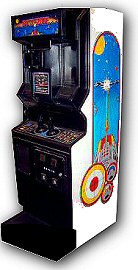
 The Game: As the pilot of a heavy tank, you wander the desolate battlefield, trying to wipe out enemy tanks and landing vehicles. (Atari, 1980)
The Game: As the pilot of a heavy tank, you wander the desolate battlefield, trying to wipe out enemy tanks and landing vehicles. (Atari, 1980)
Memories: Though the above description is exceedingly simple, Battlezone was another pillar of Atari’s stable of outstanding vector graphics games (which also included Tempest and Asteroids). With its two-stick control system, mimicking a real tank’s controls, its slowly lumbering game play, and its periscope-like screen, Battlezone was, for its day, an incredibly cool and realistic game (with a huge cabinet too).
Armor Attack
 The Game: One or two players are at the controls of speedy ground assault vehicles which can zip around an enclosed maze of open areas and buildings with almost mouse-like speed. Heavy tanks and armed helicopters routinely appear in this maze, attempting to shoot any player vehicles they spot; the player(s) can, in turn, fire back at both of these vehicles. Caution: a damaged tank may still be able to draw a bead, so it’s best to keep firing until the tanks are completely destroyed. (Cinematronics, 1980)
The Game: One or two players are at the controls of speedy ground assault vehicles which can zip around an enclosed maze of open areas and buildings with almost mouse-like speed. Heavy tanks and armed helicopters routinely appear in this maze, attempting to shoot any player vehicles they spot; the player(s) can, in turn, fire back at both of these vehicles. Caution: a damaged tank may still be able to draw a bead, so it’s best to keep firing until the tanks are completely destroyed. (Cinematronics, 1980)
Memories: However popular Atari’s vector graphics games were, the real rock-solid workhorse of that genre of gaming was the comparitively small Cinematronics. Armor Attack (whose marquee cryptically punctuates the title as “Armor… …Attack“) was no household name like Asteroids, and it may have been a mere sleeper without being a sleeper hit; the game play, for the most part, dated back to Kee Games’ Tank! from several years earlier. But it’s fondly remembered today – and made enough of a mark for a unique home version.
War Of Nerves!
 The Game: You’re the commander of a small squad of robots, and your opponent – be it a second player or the computer – is commanding a similar platoon o’ droids. Your job is to avoid the enemy’s robots while you wait for your robots to reach the enemy commander. Of course, the enemy’s robots could reach you first, but that’s another story. The only control you have over your robots is to press the action button and call them toward you. The robots fight hand-to-hand, rather than shooting, and your robots may become incapacitated. You can leap into the fray and touch one of your malfunctioning robots to repair it and return it to the fight, but in so doing, you run a risk of being captured by enemy robots. (Magnavox, 1979)
The Game: You’re the commander of a small squad of robots, and your opponent – be it a second player or the computer – is commanding a similar platoon o’ droids. Your job is to avoid the enemy’s robots while you wait for your robots to reach the enemy commander. Of course, the enemy’s robots could reach you first, but that’s another story. The only control you have over your robots is to press the action button and call them toward you. The robots fight hand-to-hand, rather than shooting, and your robots may become incapacitated. You can leap into the fray and touch one of your malfunctioning robots to repair it and return it to the fight, but in so doing, you run a risk of being captured by enemy robots. (Magnavox, 1979)
Memories: This is a game about the Arnold Rimmer vision of combat.
In the Marooned episode of Red Dwarf, Rimmer says “Generals don’t smash chairs over people’s heads. They don’t smash Newcastle Brown bottles into your face and say ‘Stitch that, Jimmy.’ They’re in the nice white tent, on the top of the hill, sipping Sancerre and directing the battle. They’re men of honor!” Which is pretty much your function in this game.
Star Battle
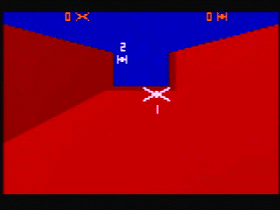 The Game: As a lone space pilot flying down a seemingly endless trench, your job is simple – blast or bomb all of the vaguely-bow-tie-shaped space fighters that you see. If your fighter is on the lower half of the screen, you’re blasting straight ahead/upward; if you move your fighter near the top of the screen, you can bomb any fighters below you. The game ends when you run out of ships; fortunately you never seem to run out of ammo. (Bally, 1979)
The Game: As a lone space pilot flying down a seemingly endless trench, your job is simple – blast or bomb all of the vaguely-bow-tie-shaped space fighters that you see. If your fighter is on the lower half of the screen, you’re blasting straight ahead/upward; if you move your fighter near the top of the screen, you can bomb any fighters below you. The game ends when you run out of ships; fortunately you never seem to run out of ammo. (Bally, 1979)
Memories: With arcade games such as Star Fire (with its obvious TIE Fighters and Star Destroyers) and Starhawk (with its own animated trench) gobbling quarters, it might just be that Star Battle for the Bally Professional Arcade is where it all begins in the console realm – the sub-genre of the Star Wars-inspired space game.
Major League Baseball
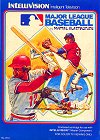 The Game: Play ball! Two teams play until they each accumulate three “outs” per inning. Try to hit the ball out of the park, or confound the outfielders with a well-placed hit none of them can catch. Steal a base if you’re feeling really brave – and then try to cover your bases as best you can when the other player tries all of these same strategies on you. (Mattel Electronics, 1979)
The Game: Play ball! Two teams play until they each accumulate three “outs” per inning. Try to hit the ball out of the park, or confound the outfielders with a well-placed hit none of them can catch. Steal a base if you’re feeling really brave – and then try to cover your bases as best you can when the other player tries all of these same strategies on you. (Mattel Electronics, 1979)
Memories: After Atari’s barely-there VCS baseball title Home Run, and the much better but still graphically simple Baseball! cartridge for the Odyssey2, Major League Baseball was a revelation. This was the moment, for many of us, when video sports games started to look like the sport they represented on home consoles. It almost redefined sports game sound too: the Intellivision has a good swipe at emulating the phrase “You’re out!” at the appropriate moment, an innovation which was nipped in the bud quickly by Mattel Electronics. Why?
Math-A-Magic! / Echo!
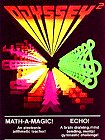 The Game: Wow! We must be in the future, for we now have electronic flash cards! This is more or less the function fulfilled by Math-A-Magic, while Echo is a slightly watered down version of the classic electronic game Simon. (Magnavox, 1979)
The Game: Wow! We must be in the future, for we now have electronic flash cards! This is more or less the function fulfilled by Math-A-Magic, while Echo is a slightly watered down version of the classic electronic game Simon. (Magnavox, 1979)
Memories: This may sound a wee bit pretentious, but this “game” – at least the Math-A-Magic! side of things – was instrumental in me getting through some problems comprehending basic math many years ago in grade school. I’m still not a math wizard – I barely passed any applied or theoretical math classes beyond Algebra I in high school and college – but way back when, this actually helped. Who said that video games can’t change anyone’s life for the better?
I’ve Got Your Number!
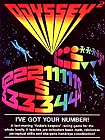 The Game: Two characters take up position on either side of two rotating clusters of numbers and symbols. A simple math problem or algebraic equation (nothing too fancy, usually just involving symbol or shape matching) appears in the bottom center of the screen, and you must guide your character to physically touch the appropriate number or symbol to correctly answer the problem. The first player to answer ten problems correctly wins the game (and, somewhat alarmingly, gets to watch his onscreen icon momentarily balloon to twice its normal size with an odd “explosion” sound). (Magnavox, 1979)
The Game: Two characters take up position on either side of two rotating clusters of numbers and symbols. A simple math problem or algebraic equation (nothing too fancy, usually just involving symbol or shape matching) appears in the bottom center of the screen, and you must guide your character to physically touch the appropriate number or symbol to correctly answer the problem. The first player to answer ten problems correctly wins the game (and, somewhat alarmingly, gets to watch his onscreen icon momentarily balloon to twice its normal size with an odd “explosion” sound). (Magnavox, 1979)
Memories: A nice, simple little educational game, this one was a bit “young” for me by the time I got an Odyssey2, but I can see where it would’ve been great for younger kids, and would probably help build a foundation for a better understanding of algebra than I was ever capable of demonstrating on paper.
Warrior
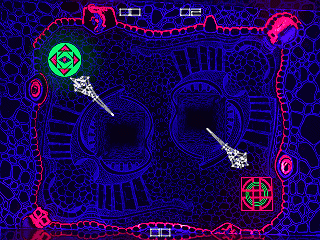 The Game: Two armored knights coalesce out of thin air in an enclosed arena, swords at the ready. Before they can do battle, there’s the matter of simply navigating the arena’s geography: a pair of bottomless pits can lead either knight to his death, and each pit is surrounded on two sides by a staircase than can make for a handy resting place – or an even deadlier place to duel. There’s also a narrow catwalk between the pits. If the knights can stay on firm ground, the sword-swinging begins; when a knight is vanquished, he re-forms in the corner where he first appeared and can charge into battle again until he has lost all of his lives. Whoever’s still standing at the end of the game wins. (Cinematronics/Vectorbeam, 1979)
The Game: Two armored knights coalesce out of thin air in an enclosed arena, swords at the ready. Before they can do battle, there’s the matter of simply navigating the arena’s geography: a pair of bottomless pits can lead either knight to his death, and each pit is surrounded on two sides by a staircase than can make for a handy resting place – or an even deadlier place to duel. There’s also a narrow catwalk between the pits. If the knights can stay on firm ground, the sword-swinging begins; when a knight is vanquished, he re-forms in the corner where he first appeared and can charge into battle again until he has lost all of his lives. Whoever’s still standing at the end of the game wins. (Cinematronics/Vectorbeam, 1979)
Memories: A great example of how new everything was in the early days of video games, Warrior is the first head-to-head fighting game, allowing two players to bash each other to bits (or stumble into the pits); there was no single-player mode. Graphically, the game is incredibly simple: the black & white vector graphics are responsible for nothing but the knights (nicely drawn and animated for the late 70s) and their respective scores. Everything else is a fluorescent-lit overhead view of the arena. That artwork could be seen through a half-silvered mirror, while the monitor itself actually displayed the graphics backwards so the mirror would show the knights over the playing field. This was a common trick of the day to achieve graphics that there simply wasn’t enough computer power to draw, but it was incredibly effective – and, at the time, it was all so new.
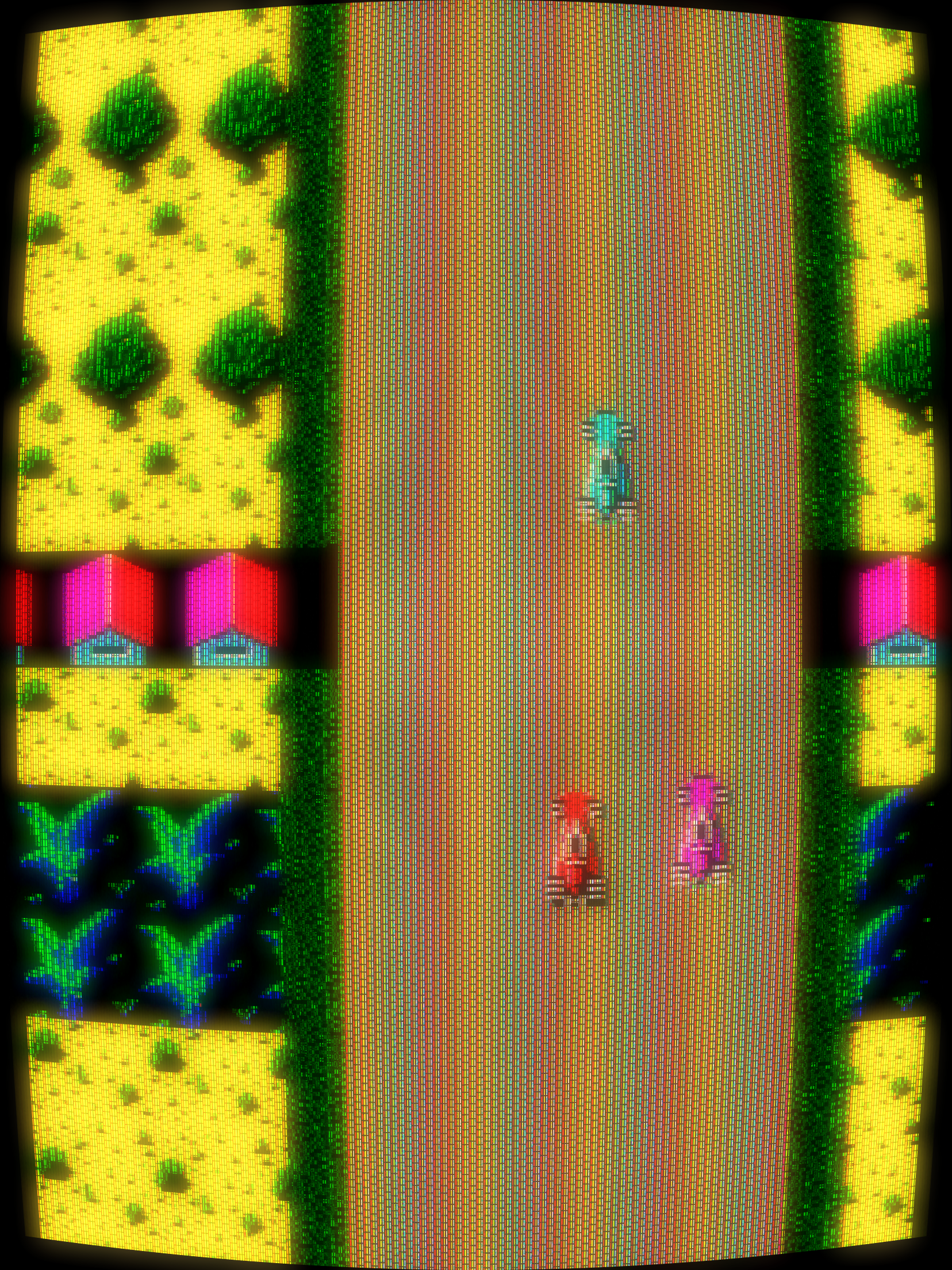
Monaco GP
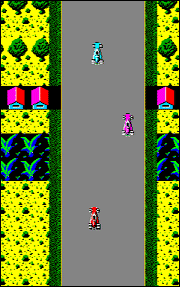 The Game: Players get behind the wheel of a roaring race car, viewed from overhead, as it navigates a series of roads and occasional tunnels whose width varies dramatically. Tunnels are illuminated only by headlights, which means that collisions with other cars are, if not certain, then at least much more likely. Any collision results in the player’s car having to get into traffic again from a dead standstill at the side of the road. (Sega, 1979)
The Game: Players get behind the wheel of a roaring race car, viewed from overhead, as it navigates a series of roads and occasional tunnels whose width varies dramatically. Tunnels are illuminated only by headlights, which means that collisions with other cars are, if not certain, then at least much more likely. Any collision results in the player’s car having to get into traffic again from a dead standstill at the side of the road. (Sega, 1979)
Memories: Monaco GP looks like just about any other overhead racing game, though it certainly upped the ante in terms of color. Its interesting take on the concept of “road widening” also made it uniquely frustrating and amusing at the same time. But as similar as it may seem to rest of the overhead-view racing games of its day, Monaco GP does hold one distinction in video game history.
Lunar Rescue

 The Game: Those pesky Space Invaders are back and this time they’ve got hostages. Your mothership hovers in orbit over the craggy, uninviting surface of the moon, waiting for you to hit the action button and signal the beginning of your mission. The docking back doors open underneath you and your lander begins dropping toward the surface. You can control where you land, and to some extent the speed, and you’ll have to weave through several rotating zones of meteoroids to reach the surface safely. Once landed, you can take on one passenger, and then you have to blast off again to ferry your man back to the mothership. Only this time, the meteors are replaced by several waves of flying saucers who will not only be happy to ram your lander, but shoot at you from above too. If you get your man home – or even if you don’t – the mission begins anew until you run out of ships. Higher difficulty levels add more enemies, such as fireballs streaking through the sky. (Taito, 1979)
The Game: Those pesky Space Invaders are back and this time they’ve got hostages. Your mothership hovers in orbit over the craggy, uninviting surface of the moon, waiting for you to hit the action button and signal the beginning of your mission. The docking back doors open underneath you and your lander begins dropping toward the surface. You can control where you land, and to some extent the speed, and you’ll have to weave through several rotating zones of meteoroids to reach the surface safely. Once landed, you can take on one passenger, and then you have to blast off again to ferry your man back to the mothership. Only this time, the meteors are replaced by several waves of flying saucers who will not only be happy to ram your lander, but shoot at you from above too. If you get your man home – or even if you don’t – the mission begins anew until you run out of ships. Higher difficulty levels add more enemies, such as fireballs streaking through the sky. (Taito, 1979)
Memories: This very obscure Space Invaders sequel takes some of the same basic ideas as Atari’s Lunar Lander (released the same year) and adds some lunar loonies and other more obviously fictional elements; Lunar Lander was good if you wanted a straight-ahead simulation of an Apollo landing, but you get to land your ship and then take off and shoot stuff in Lunar Rescue. It’s challenging and quite a bit of fun, too – I find myself playing this one for a pretty good stretch if I start.